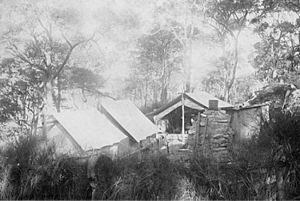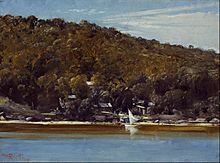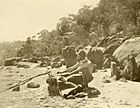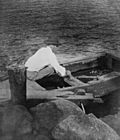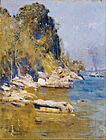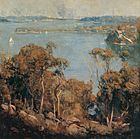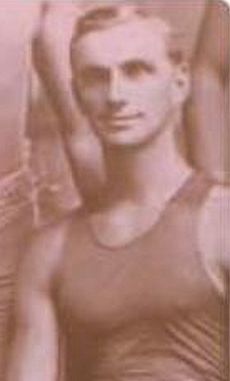Curlew Camp facts for kids
Curlew Camp was a special place where artists lived and worked. It was set up in the late 1800s. You could find it on the eastern shore of Little Sirius Cove in Sydney. Famous Australian artists like Arthur Streeton and Tom Roberts stayed here. They were part of a group called the Heidelberg School. Many of their best-known paintings were created right here.
Today, the area still looks natural. The Mosman Council made a walking path called the "Curlew Camp Artist's Walk." This path shows the route artists took from the ferry. It starts at the South Mosman ferry wharf and goes along the water. The walk is about 1.6 kilometers long. It ends near the Taronga Zoo Wharf.
Life at Curlew Camp
Curlew Camp began around 1890. A rich clothing maker named Reuben Brasch started it. He and his brothers used the camp for fun on weekends. In 1891, Arthur Streeton moved to Curlew Camp. He was 24 years old and came from Melbourne. Soon after, Tom Roberts joined him.
To earn money, they taught art classes in Sydney. They even put an advertisement in a newspaper in 1893. Both artists loved painting outdoors, which is called plein air. So, living in the camp suited them well.
In these early years, Curlew Camp was small but comfy. Streeton described it later in his life. He said there were a few men and about six tents. They had a dining tent and a dance floor. There was even a small piano! He said they lived well for about 12 shillings and sixpence a week.
Julian Ashton sometimes visited Curlew Camp. He mostly stayed at another artist's camp nearby. He remembered Streeton and Roberts well. He said Streeton would buy food and supplies. He would blow a whistle for a boat to pick him up. Ashton remembered Streeton returning, "laden with parcels of bread, beer and beef." He said the artists didn't need much. But their hopes for the future were huge.
While at the camp, Streeton wrote many letters. He often described camp life in a colorful way. In the early 1890s, he wrote about looking at the bay. He saw "massive purple shadow" on the hill. He also wrote about flowers and ferns. He gathered them to plant in their small summer house.
In April 1891, he wrote about plants climbing around his tent. He mentioned "tender gum-leaf" and "honeysuckle." He also described the "beautiful flood beneath." One night, he wrote, "My tent stands like a quiet glowing lamp." He added, "All alone in the camp tonight."
In 1896, he wrote about sitting in his tent. He saw the "deep green blue" night sky. He also saw "picnic parties pulling about quietly." Steamers were "puffing breathing heavily." He felt "all with me is melody."
Tom Roberts was 35 when he came to Curlew Camp. He was different because he always dressed nicely. He wanted to paint portraits. For this, he felt he needed to look important. Another artist said Roberts "represented the successful artist."
In 1896, Tom Roberts got married. He left the camp to live in Balmain. Streeton stayed for two more years. Then, in 1898, he went to England. He came back to Australia for a short time in 1907. He visited Curlew Camp again. From a spot above the camp, he painted some of his most famous works.
Streeton always remembered his time at Curlew. In 1940, a reporter visited him. The reporter saw a photo of Streeton at Curlew. It was hanging above his fireplace. Streeton looked back on that time with happiness. In 1943, near the end of his life, he wrote a letter. He sketched a map of the camp's location. He said it was "quite exciting" to think about the camp.
Other artists also lived at the camp. Henry Fullwood painted "Sirius Cove" in 1895. Musicians like William Marshall-Hall and Alfred Hill also stayed there.
Curlew Camp After 1900
After the painters left, Curlew Camp changed. It became a place for people who loved sailing. It was also for those who enjoyed outdoor life. Frederick Lane became the owner of the camp. Lane was a famous Australian Olympic swimmer. He won two gold medals in Paris in 1900.
When he came back from the Olympics, he lived at the camp. He traveled to the city for his printing job. Lane stayed at the camp until he got married in 1908. The camp grew bigger and more organized during this time. It had a dining room made of wood. There was also a billiards tent.
The camp closed in 1912. This happened because the Taronga Park Zoo was built on the hill above the site.
The exact spot of the camp was forgotten. But its old remains were found in 1987. Mr. Rob Sturrock of Mosman Rotary Club rediscovered them. His books show a map of a walking path. This path went from Musgrave Street wharf to Sirius Cove.
Today, Mosman Council has created the Curlew Camp Artists Walk. Visitors can enjoy this walk.



